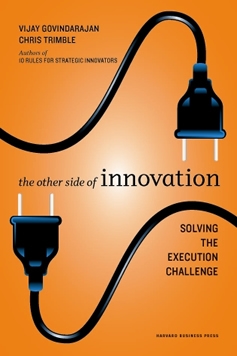About the Book
"Through innovation, business organizations can change the world. There is just one little problem. Business organizations are not built for innovation; they are built for efficiency."
From the Preface to The Other Side of Innovation
 In 2007, IBM ran an advertisement intended to convey that it could help its clients innovate. It featured a pudgy mock superhero sporting a capital “I” on his outfit who introduced himself as “Innovation Man.” An amused colleague asked, “And your job is?” The superhero responded, with gusto, “I for Ideation!, I for invigoration! I for incubation!” The onlooker replied, “What about I for Implementation?” Innovation Man: “I knew I forgot something.”
In 2007, IBM ran an advertisement intended to convey that it could help its clients innovate. It featured a pudgy mock superhero sporting a capital “I” on his outfit who introduced himself as “Innovation Man.” An amused colleague asked, “And your job is?” The superhero responded, with gusto, “I for Ideation!, I for invigoration! I for incubation!” The onlooker replied, “What about I for Implementation?” Innovation Man: “I knew I forgot something.”
The ad captured, so humorously and yet so perfectly, the off-balance approach to innovation that is commonplace in corporations around the world. There is too much emphasis on ideas, not nearly enough emphasis on execution.
No wonder, then, that so many innovation initiatives hit a wall. The guiding managerial model for innovation is just too simple. It reduces to:
Innovation = Ideas
As a result, most corporations have more ideas than they can possibly move forward with. Far too many promising ideas on paper never become anything more than … promising ideas on paper. Here is an improved equation for innovation:
Innovation = Ideas + Execution
In The Other Side of Innovation, the authors offer practical advice for senior executives, chief innovation officers, leaders of innovation initiatives, members of innovation teams, aspiring innovators, and all those who support innovation. The principles and recommendations in the book span the full spectrum of innovation initiatives—from small process improvements to high-risk new ventures.
A fundamental premise underlying the book is that each innovation initiative needs a special kind of team and a special kind of plan. Part I of The Other Side of Innovation focuses on the team; Part II focuses on the plan.
In Part I Govindarajan and Trimble explain the steps for building the project team:
- Divide the labor. Decide how responsibilities for executing the innovation initiative will be split between the two components of the project team: The Dedicated Team, which works on the initiative full time; and the Shared Staff, who work on the initiative part time while maintaining ongoing operations.
- Assemble the Dedicated Team. Determine who will serve on the Dedicated Team and how to define their roles and responsibilities.
- Manage the partnership. Establish clear expectations for each partner and mediate the inevitable conflicts that will arise between the two.
In Part II they examine three steps for planning an innovation initiative and evaluating its progress:
- Formalize the experiment. The basic principles for learning from experiments are familiar but hard to follow.
- Break down the hypothesis. All but the simplest innovation initiatives are really compound experiments. There are two or more uncertain conjectures.
- Seek the truth. Myriad pressures in organizations push people toward interpretations of results that are comfortable and convenient rather than analytical and dispassionate. These pressures must be understood and overcome.
The Other Side of Innovation is the essential guidebook for making innovation happen.